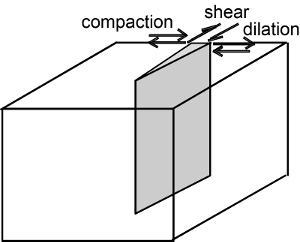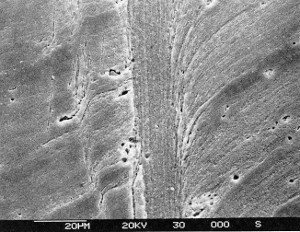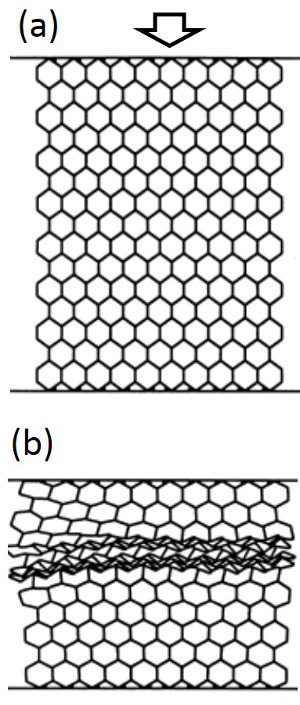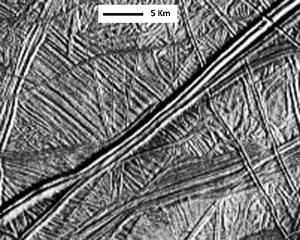| ||||||||||||
|
|
||||||||||||
|
|
||||||||||||
| Deformation Bands | ||||||||||||
|
Deformation bands are thin, tabular bands of localized deformation (Figure 1), also referred to as Luders bands or granulation seams in earlier literature. Following Aydin (1978) we will use the former because it includes a wider variety of structures; Luders bands are thought to have no shear offset and granulation is associated with only certain types of bands. Single deformation bands are about a few mm to a few cm thick, and their lengths rarely exceed one hundred meters. See 'Geometry, Statistics, and Scaling of Deformation Bands' and under the link, 'Properties of Deformation Bands.' The strain accommodated by single deformation bands is also relatively small. In spite of such small dimensions and small strain magnitude, even single deformation bands are easily recognized in the field, thanks to their commonly positive relief and the color difference between band materials and the surrounding parent rock.
Recent studies have documented a rich variability in their overall kinematics (Aydin et al., 2006, Fossen et al., 2007). Among these are shear bands and volumetric bands, which can also be divided into compaction bands and dilation bands (see various kinematics represented by a pair of arrows in Figure 1). The first type mentioned above has predominantly shear deformation across which the sense of motion is primarily parallel to the overall structure, while the last two are structures with predominantly volumetric deformation across which the sense of motion is towards or away from the structures. However, these appear to be the end members of deformation bands of a broad kinematic spectrum as mentioned above. For example, shear bands with compaction or dilation commonly occur, as do volumetric bands with some component of shear. Deformation bands are known to occur in a wide variety of natural and man-made materials. Deformation bands in steels and aluminum alloys have been known for a long time in the engineering literature. Figure 2 shows adiabatic shear bands in aluminum alloy from Leach (1985). Figure 3(a) shows a sheet of polycarbonate hexagonal honeycombs of 0.0057 inches thick subjected to axial compression in both laboratory and numerical experiments by Papka and Kyriakides (1998). Predominantly compactive deformation bands were formed by collapsing of cells of honeycombs (Figure 3b). One of the least expected materials to have deformation bands is ice on the basis of its highly brittle nature in common familiar environments on earth. Yet, satellite images of the surface of Jupiter's icy moon, Europa, display astonishing arrays of lineaments (http://galileo.jpl.nasa.gov), some of which have been interpreted as faults (Kattenhorn, 2004) and deformation bands (Aydin, 2006). Figure 4 is a satellite image showing the Androgeos Linea (the diagonal lineament from upper right to lower left) and the surrounding features from the Bright Plains area of Europa. Some of these lineaments including the Androgeos Linea were proposed to be deformation bands produced by the transformation of one form of crystalline structure of ice to another (Aydin, 2006).
Loose sand grains (Viggiani et al., 2008) and poorly consolidated sediments (Cashman and Cashman, 2000; Aydin et al., 2006) including mud (Karig and Lundberg, 1990), carbonate grain stones (Tondi et al., 2006), and sandstones of various types (for example aeolian sandstone in Figure 5) make up a wide spectrum of granular materials in which deformation bands have been known to occur. These will be described in details later in this Knowledgebase.
| ||||||||||||
| Types of Deformation Bands: | ||||||||||||
| Volumetric BandsShear Bands Splay Deformation BandsEchelon Deformation BandsComposite Deformation Bands Hybrid Deformation Bands | ||||||||||||
| Reference: |
||||||||||||
| Aydin, A., Borja, R., Eichhubl, P., 2006 Aydin, A., 2006 Cashman, S., Cashman, K., 2000 Fossen, H., Schultz, R.A., Shipton, Z.K., Mair, K., 2007 Karig, D.E., Lundberg, N., 1990 Kattenhorn, S., 2004 Leach, P.W., 1985 Papka, S.D., Kyriakides, S., 1998 Tondi, E., Antonellini, M., Aydin, A., Marchegiani, L., Cello, G., 2006 Viggiani, G., Kuntz, M., Desrues, J., 2008 |
||||||||||||
|
Readme | About Us | Acknowledgement | How to Cite | Terms of Use | Ⓒ Rock Fracture Knowledgebase |
||||||||||||




